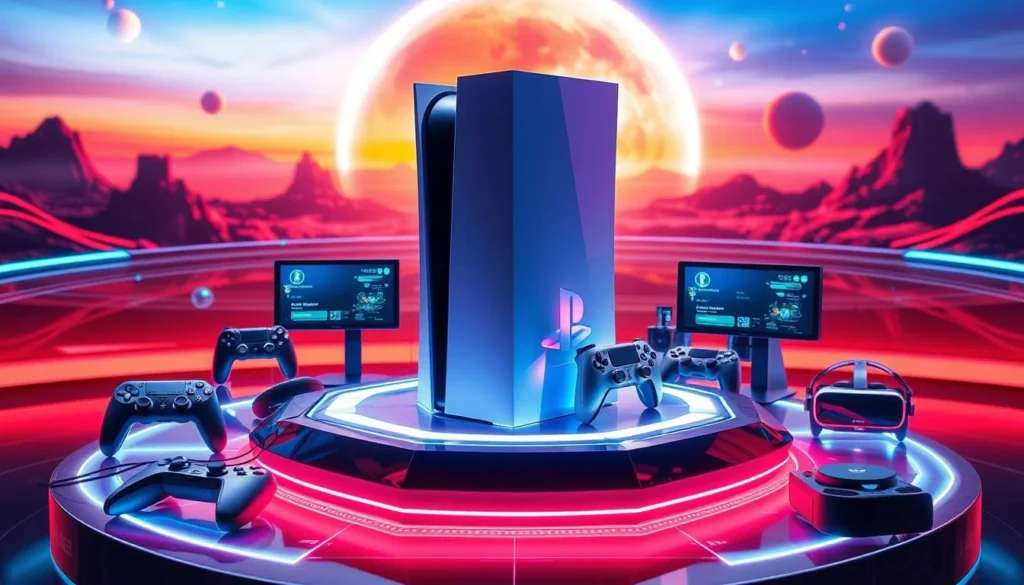The gaming community is excited about the possible PS6 release date. Building upon the legacy of its predecessors, the PS6 promises to elevate the gaming experience to unprecedented heights. But what exactly can we expect from this upcoming console?
A Legacy of Innovation
Sony’s journey in the gaming industry began with the original PlayStation, launched in Japan on December 3, 1994. This console revolutionized gaming with its 32-bit graphics and CD-ROM format, setting the stage for future innovations. Over the years, each subsequent PlayStation model has introduced groundbreaking features:
- PlayStation 2 (2000): Introduced DVD playback and became the best-selling console of all time.
- PlayStation 3 (2006): Brought Blu-ray support and online gaming to the forefront.
- PlayStation 4 (2013): Focused on social gaming and introduced the PlayStation VR.
- PlayStation 5 (2020): Delivered ultra-high-speed SSDs and ray tracing capabilities.
This consistent track record of innovation has solidified Sony’s position as a leader in the gaming industry.
PS6 Release Date: What We Know So Far
The anticipation for Sony’s next-generation console, the PlayStation 6 (PS6), is palpable. Gamers worldwide are eager to know when they can get their hands on this new system. Let’s delve into Sony’s historical release patterns, current rumors, and what they might tell us about the PS6’s launch.
Sony’s Console Release History
Understanding Sony’s past console release timelines can provide insights into the PS6’s potential debut. Here’s a breakdown of previous PlayStation launches:
| Console | Release Year | Years Between Releases |
| PlayStation (PS1) | 1994 | – |
| PlayStation 2 (PS2) | 2000 | 6 |
| PlayStation 3 (PS3) | 2006 | 6 |
| PlayStation 4 (PS4) | 2013 | 7 |
| PlayStation 5 (PS5) | 2020 | 7 |
As observed, Sony typically releases a new console every 6 to 7 years. Following this pattern, the PS6 would be slated for release between 2026 and 2027.
Current Speculations and Leaks
While Sony has not officially announced the PS6’s release date, several leaks and industry insiders have provided potential timelines:
- 2027 Release: Recent reports suggest that the PS6 could launch in late 2027.
- 2028 Release: Other sources indicate a possible 2028 release, aligning with an 8-year cycle from the PS5’s 2020 launch.
These projections suggest that the PS6’s release could extend beyond Sony’s traditional 6-7 year cycle, possibly due to advancements in technology or market dynamics.
PS5 Lifecycle and Overlap Considerations
The PS5, launched in 2020, has seen significant success, with over 40 million units sold as of 2024. Sony typically supports its consoles well into the next generation, ensuring a smooth transition for users.
Considering this, it’s plausible that the PS5 will continue to receive support and new titles even after the PS6’s release, similar to how the PS4 remained relevant post-PS5 launch.
When Will the PS6 Come Out? Predictions & Timeline
Sony has yet to make an official announcement, industry experts and analysts have weighed in with their predictions, offering insights into the potential launch window and the factors that might influence it.
Insights from Industry Experts
Historically, Sony has maintained a 6 to 7-year gap between console releases. The PlayStation 5 (PS5) debuted in November 2020, suggesting a possible PS6 release around 2026 or 2027. However, recent reports indicate that this cycle might extend. For instance, some analysts predict that the PS6 could arrive as early as 2028, aligning with Sony’s typical console lifecycle.
Speculation on 2026 vs. 2028 Release
Several factors contribute to the debate over whether the PS6 will launch in 2026 or 2028:
- Technological Advancements: Waiting until 2028 could allow Sony to incorporate more advanced technologies, ensuring the PS6 offers a significant leap over its predecessor.
- Market Dynamics: Extending the PS5’s lifecycle might maximize its market potential, especially if sales remain strong.
- Development Timelines: A longer interval provides developers ample time to create launch titles that fully utilize the new hardware’s capabilities.
Conversely, a 2026 release could capitalize on the current momentum and address the growing demand for next-gen experiences.
Factors Influencing the Release Date
Several key elements are likely to influence Sony’s decision on the PS6’s launch timing:
- Market Demand: The sustained popularity of the PS5 and consumer appetite for new technology play crucial roles.
- Competition: Rival companies, such as Microsoft with its Xbox series, may impact Sony’s timeline to maintain a competitive edge.
- Technological Readiness: The availability of cutting-edge components and manufacturing capabilities will determine when Sony can feasibly produce the PS6.
- Economic Conditions: Global economic factors, including supply chain stability and consumer spending power, could either hasten or delay the release.
PS6 Announcement & News: Has Sony Confirmed Anything?
Gamers everywhere are eagerly awaiting Sony’s upcoming console, the PlayStation 6 (PS6). While official details remain scarce, a combination of Sony’s historical patterns, recent reports, and industry leaks provide insights into the potential development and announcement timeline of the PS6.
Official Statements and Development Updates
As of now, Sony has not released an official statement confirming the development or release date of the PS6. However, industry reports suggest that Sony has been working on the PS6 since 2022. Notably, in 2022, Sony engaged in discussions with both AMD and Intel for the PS6’s chip design. Ultimately, AMD secured the contract, with backward compatibility being a significant factor in this decision. This collaboration indicates that the PS6 is in active development, even if Sony hasn’t publicly acknowledged it yet.
Sony’s History of Console Announcements
Understanding Sony’s previous console announcement patterns can offer clues about when the PS6 might be revealed. Here’s a look at the timeline for past PlayStation consoles:
| Console | Announcement Date | Release Date | Time Between Announcement and Release |
| PlayStation 4 | February 20, 2013 | November 15, 2013 | ~9 months |
| PlayStation 5 | November 12, 2019 | November 12, 2020 | ~12 months |
Based on this pattern, Sony typically announces a new console approximately 9 to 12 months before its release. If the PS6 is projected for a late 2027 release, an official announcement could occur in late 2026 or early 2027.

Leaks, Patents, and Rumors
Several leaks and patents have surfaced, fueling speculation about the PS6’s development:
- Chipset Development: Reports indicate that the PS6’s chipset design was finalized in 2024, with production expected to commence in late 2025 or early 2026. This timeline supports a potential 2027 release.
- AMD Partnership: Sony’s decision to collaborate with AMD for the PS6’s chip design emphasizes a commitment to backward compatibility, ensuring that PS5 games will be playable on the new console.
- Innovative Features: A patent filed by Sony hints at a potential “gameplay rewind” feature, allowing players to reverse and replay segments of gameplay. While patents don’t always translate to final products, this showcases Sony’s interest in enhancing user experience.
Potential Announcement Events
Sony has a history of unveiling major products during prominent gaming events or through dedicated showcases:
- PlayStation Showcase: These are exclusive events where Sony reveals significant updates and new hardware. The PS5, for instance, was unveiled during a dedicated PlayStation Showcase.
- E3 (Electronic Entertainment Expo): Historically, E3 has been a platform for major gaming announcements. However, Sony has occasionally opted out of E3 in favor of its own events.
- State of Play: Sony’s periodic digital presentations, known as “State of Play,” provide updates on upcoming games and hardware. While typically focused on software, a special edition could be used for a hardware announcement.
Given the significance of a new console launch, it’s plausible that Sony would choose a dedicated PlayStation Showcase or a major industry event to announce the PS6.
PS6 Pricing & Cost: How Much Will It Be?
As anticipation builds for Sony’s next-generation console, the PlayStation 6 (PS6), discussions about its potential pricing are heating up. While Sony has yet to release official details, analyzing historical data, industry trends, and expert opinions can provide insights into the expected cost of the PS6.
Historical Pricing Trends
Understanding the pricing trajectory of previous PlayStation consoles offers a foundation for predicting the PS6’s price point. Here’s a breakdown of past console launch prices:
| Console | Release Year | Launch Price |
| PlayStation 3 (PS3) | 2006 | $499 – $599 |
| PlayStation 4 (PS4) | 2013 | $399 |
| PlayStation 5 (PS5) | 2020 | $399 (Digital Edition) / $499 (Standard Edition) |
| PlayStation 5 Pro (PS5 Pro) | 2024 | $699 |
Note: Prices are based on available data and may vary by region.

Expected Price Range for PS6
Given the upward trend in console pricing, especially with the PS5 Pro launching at $699, analysts speculate that the PS6 could debut at a similar or slightly higher price point. Estimates suggest a range between $600 and $700 for the base model. This projection considers advancements in hardware, potential inflation, and market competition.
Potential PS6 Models
Sony has a history of offering multiple console variants to cater to different market segments. The PS5, for instance, launched with both a Digital Edition and a Standard Edition. It’s plausible that the PS6 will follow suit, potentially introducing:
- Standard Edition: Includes a disc drive for physical media.
- Digital Edition: Omitting the disc drive, likely at a lower price point.
- Pro Version: Enhanced performance and features, possibly at a premium price.
These options would allow consumers to choose a model that best fits their preferences and budget.
Factors Influencing PS6 Pricing
Several elements could impact the final retail price of the PS6:
- Hardware Advancements: Incorporating cutting-edge technology, such as advanced processors and graphics capabilities, can increase production costs.
- Production Costs: Manufacturing expenses, including component sourcing and assembly, play a significant role in pricing decisions.
- Market Competition: Pricing strategies may be influenced by competing consoles and gaming platforms.
- Economic Conditions: Global economic factors, including inflation and currency fluctuations, can affect pricing.
Subscription Models and Financing Options
To make the PS6 more accessible, Sony might offer various purchasing options:
- Subscription Bundles: Combining the console with services like PlayStation Plus or PlayStation Now at a discounted rate.
- Financing Plans: Allowing consumers to pay for the console in installments over time.
- Trade-In Programs: Offering credits or discounts for trading in previous-generation consoles.
These initiatives could lower the barrier to entry for consumers and enhance the overall value proposition.
PS6 Rumors & Existence: Is Sony Making a PlayStation 6?
Gamers around the world are eagerly awaiting Sony’s upcoming console, the PlayStation 6 (PS6). While official announcements are pending, various indicators suggest that Sony is actively developing the PS6. Let’s delve into the current rumors, potential features, and evidence pointing toward its existence.
Sony’s Commitment to Console Development
Despite the growing trend toward cloud gaming, Sony remains dedicated to traditional console experiences. Hideaki Nishino, Sony’s Senior Vice President of Platform Experience, has indicated that while it’s early to discuss the PS6, the company is not delaying its launch if the appropriate technology is available. This commitment underscores Sony’s belief in the continued relevance of dedicated gaming hardware.
Rumored PS6 Features
Several exciting features are rumored for the PS6, aiming to elevate the gaming experience:
- Virtual Reality (VR) Integration: Building upon the success of PSVR, the PS6 may offer advanced VR capabilities, potentially with a new headset delivering higher resolution and improved motion tracking.
- AI-Driven Gaming: The integration of artificial intelligence could lead to more adaptive and intelligent NPCs, as well as personalized gaming experiences that adjust to individual playstyles.
- Cloud-Based Gaming Services: While maintaining physical hardware, Sony might expand its cloud gaming services, allowing players to stream games seamlessly without downloads.
- Backward Compatibility: A significant focus for the PS6 is ensuring compatibility with PS5 titles, allowing gamers to continue enjoying their existing libraries.
Evidence of PS6 Development
Several indicators point toward the active development of the PS6:
- Hardware Partnerships: In 2022, Sony engaged in discussions with AMD and Intel for the PS6’s chipset design. AMD secured the contract, emphasizing the importance of backward compatibility—a feature highly requested by the gaming community.
- Job Listings: Sony has posted job openings that hint at next-generation console development. For instance, a 2021 listing sought engineers for “next-generation gaming system” development, suggesting early-stage work on the PS6.
- Developer Leaks: Firesprite, a PlayStation Studio, has listed positions for a “dark” AAA title with photorealistic graphics, intended for next-generation hardware. This project could be among the first exclusives for the PS6.
Potential Release Timeline
While Sony has not officially announced a release date, patterns and reports suggest a possible launch window:
- Historical Cycles: Sony typically releases new consoles every 6-7 years. With the PS5 debuting in 2020, the PS6 could arrive between 2026 and 2027.
- Industry Insights: Documents from Microsoft’s Activision Blizzard acquisition case mention a new PlayStation console expected around 2027.
These projections align with the notion that the PS6 is on the horizon, potentially launching in late 2027.
PS6 Release Year Speculation: Will It Launch in 2026 or Later?
The gaming community is abuzz with anticipation for Sony’s next-generation console, the PlayStation 6 (PS6). While Sony has yet to make an official announcement, various factors—including industry trends, hardware advancements, and the lifecycle of the PlayStation 5 (PS5)—provide insights into the potential release window for the PS6.
Pros and Cons of a 2026 vs. 2028 Release
2026 Release:
Pros:
- Market Momentum: Launching in 2026 could capitalize on the existing enthusiasm for next-gen gaming, maintaining Sony’s competitive edge.
- Technological Relevance: A shorter interval ensures the PS6 incorporates the latest technologies without significant lag.
Cons:
- Development Constraints: Accelerating the release may pressure developers, potentially leading to compromises in hardware innovation and game quality.
- Market Saturation: The PS5, especially with the recent release of the PS5 Pro, may not have reached its full market potential by 2026.
2028 Release:
Pros:
- Advanced Technology Integration: A later release allows for the inclusion of more mature and advanced technologies, offering a significant leap over current-gen consoles.
- Extended PS5 Lifecycle: This timeline provides the PS5 and PS5 Pro ample time to saturate the market, maximizing return on investment for both consumers and Sony.
Cons:
- Competitive Pressure: Delaying until 2028 could provide competitors an opportunity to capture market share with earlier next-gen releases.
- Consumer Anticipation Fatigue: A prolonged wait might lead to diminished consumer excitement or impatience.
Influencing Factors on the PS6 Launch Window
Several key elements are likely to influence Sony’s decision regarding the PS6’s release timing:
- Gaming Trends: The rise of cloud gaming and subscription-based services is reshaping the industry. Sony may consider how the PS6 can integrate or compete with these trends.
- Hardware Limitations: Advancements in processing power, graphics capabilities, and storage solutions are crucial. Waiting for significant technological breakthroughs could justify a later release.
- PlayStation 5 Sales Performance: The PS5 has seen robust sales since its 2020 launch. Introducing the PS5 Pro in 2024 aims to extend the console’s lifecycle. Strong ongoing sales might encourage Sony to delay the PS6 to avoid market cannibalization.
Impact of Mid-Generation Upgrades
The introduction of mid-generation upgrades, such as the PS5 Pro, plays a pivotal role in the timing of the PS6:
- Extended Console Lifespan: The PS5 Pro offers enhanced performance, catering to enthusiasts and prolonging the relevance of the PS5 platform. This extension can provide Sony with flexibility in planning the PS6 release.
- Market Segmentation: Offering a premium console option allows Sony to address different market segments, potentially easing the transition to the next generation.
- Development Focus: Resources allocated to mid-generation upgrades might impact the development timeline of the PS6, potentially leading to a later release.
PlayStation 6 International Search Queries: Global Interest in the PS6
The anticipation for Sony’s next-generation console, the PlayStation 6 (PS6), is palpable across the globe. Gamers from various regions are eager to know when the PS6 will be available in their markets and are actively seeking information in their native languages. This section delves into the expected regional release timelines, translates the most searched PS6-related queries, and examines Sony’s historical launch strategies to predict the PS6’s rollout plan.
Regional Release Expectations
While Sony has not officially announced the PS6 release date, industry trends and historical patterns offer insights into potential regional launch timelines.
| Region | Expected Release Timeline | Notes |
| United States | Late 2027 | Historically, Sony prioritizes major markets like the U.S. for initial console releases. |
| United Kingdom | Late 2027 | The UK often aligns with the U.S. in receiving new consoles during the first wave of releases. |
| Japan | Late 2027 | As Sony’s home country, Japan is typically among the first regions to receive new PlayStation consoles. |
| Latin America | Early to Mid 2028 | Previous console releases have seen a staggered rollout, with Latin American countries receiving consoles a few months post-initial launch. |
Please note that these timelines are speculative and based on historical release patterns. Official dates may vary.
Sony’s Historical Launch Strategy
Sony’s approach to console releases provides insight into how the PS6 rollout might unfold.
- Simultaneous Global Launch: The PlayStation 5 (PS5) saw a near-simultaneous release in major markets, with the U.S., Japan, Canada, Mexico, Australia, New Zealand, and South Korea receiving the console on November 12, 2020, followed by other regions on November 19, 2020.
- Staggered Rollout: Earlier consoles, like the PlayStation 4 (PS4), experienced a more staggered release, launching in North America first, followed by Europe and other regions.
Given the success of the PS5’s launch strategy, it’s plausible that Sony will adopt a similar approach for the PS6, aiming for a broad initial release to meet global demand effectively.
PlayStation 6 & Future Consoles: What Comes Next?
As the gaming industry evolves, questions arise about the trajectory of Sony’s hardware development beyond the anticipated PlayStation 6 (PS6). This section explores whether the PS6 might be Sony’s final traditional console, the potential for future iterations like the PS7 and PS8, and how emerging technologies such as cloud gaming and artificial intelligence (AI) could reshape the PlayStation ecosystem.
Will the PlayStation 6 Be Sony’s Last Traditional Console?
Industry analysts suggest that the PS6 could mark a significant shift in Sony’s console strategy. Mat Piscatella, a noted industry analyst, has speculated that the PS6 might be the last PlayStation console to support physical media, transitioning towards an all-digital future.
This potential move aligns with broader industry trends favoring digital distribution and cloud-based services, reducing reliance on physical hardware.
The Future of PlayStation: PS7, PS8, and Beyond
While the PS6 is poised to continue Sony’s legacy of traditional consoles, the landscape for subsequent generations like the PS7 and PS8 may differ markedly. Sony’s strategic focus appears to be expanding beyond standalone hardware to encompass a more integrated gaming ecosystem. This includes cloud gaming initiatives, AI-driven experiences, and increased support for PC and mobile platforms.
Such developments suggest that future PlayStation iterations might prioritize seamless, platform-agnostic gaming experiences over conventional console releases.
How Cloud Gaming and AI-Driven Experiences Might Reshape the Future of PlayStation
Emerging technologies are set to redefine gaming paradigms, with Sony actively exploring these frontiers:
- Cloud Gaming: The introduction of devices like the PlayStation Portal underscores Sony’s commitment to cloud-based gaming. This handheld accessory allows users to stream PS5 games without a physical console, indicating a shift towards hardware-light gaming solutions.
- Artificial Intelligence: Sony is investing in AI technologies to enhance gameplay experiences. Innovations include predictive AI systems capable of anticipating player actions, leading to more responsive and immersive gaming environments.
These advancements suggest a future where gaming is increasingly accessible, personalized, and less dependent on traditional console hardware.
Conclusion
The anticipation surrounding Sony’s next-generation console, the PlayStation 6 (PS6), continues to grow. While official details remain scarce, industry patterns and insider reports suggest a potential release window around late 2027. This projection aligns with Sony’s historical 6-7 year console lifecycle, as seen with previous generations.
For gamers contemplating whether to invest in a PlayStation 5 (PS5) now or wait for the PS6, several factors come into play. The PS5, including its enhanced PS5 Pro variant, offers a robust gaming experience with a vast library of titles and ongoing support. Considering the PS6’s projected release is still several years away, opting for a PS5 now ensures immediate access to current and upcoming games. Additionally, the PS5 Pro, launched in November 2024, provides enhanced performance for those seeking a premium experience.
However, if you prefer to have the latest hardware and are willing to wait, holding out for the PS6 could be worthwhile. It’s essential to weigh your current gaming needs and preferences against the timeline of the PS6’s release.
As the gaming landscape evolves, staying informed is crucial. We encourage readers to monitor official updates from Sony to make well-informed decisions about their gaming investments.
FAQs
1. When is the PS6 expected to be released?
Sony has not officially announced a release date, but based on industry trends, the PS6 could launch in 2026 or later.
2. How much will the PS6 cost?
The PS6 is expected to be priced between $499 and $699, depending on hardware improvements and model variations.
3. Will the PS6 support PlayStation 5 games?
Backward compatibility is likely, given Sony’s support for older PlayStation games on the PS5.
4. Is Sony working on a PlayStation 6?
Yes, leaks, patents, and industry reports suggest that Sony is actively developing the PS6. However, no official confirmation has been given yet.
5. Will the PS6 be the last PlayStation console?
While Sony is investing in cloud gaming, traditional consoles are still popular. The PS6 is unlikely to be Sony’s last console, but future PlayStations might rely more on digital and cloud-based gaming.






